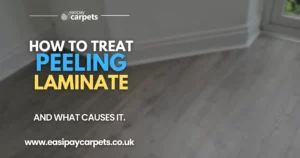

How To Replace Laminate Flooring Like A Pro!
Laminate flooring is a popular choice for homeowners due to its durability, affordability, and ease of installation. However, over time, even the best laminate floors can become damaged due to wear and tear, moisture, or accidents. Whether it’s a cracked plank, water-damaged boards, or a worn-out area, replacing damaged laminate flooring can restore the beauty of your space without the need for a complete overhaul. In this guide, you’ll learn how to replace damaged laminate flooring like an expert, with step-by-step instructions, essential tools, and pro tips to ensure a seamless result.
Why Replace Damaged Laminate Flooring?
Damaged laminate flooring not only affects the appearance of your home but can also lead to further issues such as moisture penetration, uneven surfaces, and potential tripping hazards. Here are some reasons to consider replacing damaged laminate planks:
- Aesthetic Appeal: Damaged or worn-out planks can ruin the overall look of your floor. Replacing them keeps your flooring looking fresh and new.
- Prevent Further Damage: Damaged planks can allow moisture to seep through to the subfloor, causing swelling, warping, or mold growth.
- Safety Concerns: Cracked or uneven planks can pose a tripping hazard, especially in high-traffic areas.
- Cost-Effective Solution: Replacing individual planks is more affordable than redoing the entire floor, saving time and money.
Tools Needed to Replace Laminate Planks
Before you start replacing damaged laminate flooring, gather the necessary tools and materials to ensure a smooth process:
- Replacement Laminate Planks: Make sure you have matching planks in colour, pattern, and thickness.
- Circular Saw or Jigsaw: For cutting damaged planks and trimming new ones to size.
- Utility Knife: To score and remove sections of damaged planks.
- Pull Bar and Tapping Block: For positioning and locking the new planks into place.
- Rubber Mallet: To tap planks together without damaging them.
- Measuring Tape: To measure the planks and ensure accurate cuts.
- Wood Glue (Optional): For a more secure fit in areas prone to shifting.
- Spacers: To maintain expansion gaps around the perimeter of the floor.
- Pry Bar or Chisel: To carefully lift and remove damaged planks.
- Safety Gear (Gloves, Goggles): To protect yourself during the removal and installation process.
Replacing Laminate Flooring Step by Step
Replacing damaged laminate flooring may seem daunting, but with the right tools and steps, you can achieve a professional result. Follow this step-by-step guide to replace damaged laminate planks like an expert:
1. Identify the Damaged Planks and Gather Supplies
- Step: Determine which planks need replacing and gather all necessary tools and materials, including replacement planks that match the existing flooring.
- Why It’s Important: Ensuring you have all the materials and tools on hand helps streamline the replacement process and prevents delays.
2. Remove Baseboards or Mouldings
- Step: Carefully remove the baseboards or mouldings around the perimeter of the room using a pry bar. This provides access to the edges of the laminate flooring.
- Why It’s Important: Removing the baseboards allows you to lift and remove planks without damaging the surrounding area.
3. Unlock and Lift the Planks (For Click-Lock Systems)
- Step: Start at the nearest wall to the damaged planks and begin unlocking the click-lock mechanism by lifting each plank. Continue removing planks until you reach the damaged one.
- Why It’s Important: This method is less invasive and preserves the integrity of the locking mechanism for future use.
4. Cut and Remove the Damaged Plank (For Glued or Centre Planks)
- Step: If the damaged plank is in the middle of the floor and cannot be accessed by lifting, use a circular saw or jigsaw to cut along the edges of the damaged plank. Be careful not to cut through the subfloor.
- Why It’s Important: Cutting the damaged plank allows you to remove it without disturbing the surrounding planks.
5. Remove the Damaged Plank Pieces
- Step: Use a utility knife and pry bar to lift and remove the cut pieces of the damaged plank. Clean the area of any debris or adhesive residue.
- Why It’s Important: A clean surface ensures a secure and level installation for the new plank.
6. Prepare the Replacement Plank
- Step: Trim the replacement plank’s tongue and groove edges as needed to fit it into place. For click-lock systems, you may need to modify the locking edge slightly.
- Why It’s Important: Properly preparing the replacement plank ensures it fits snugly and aligns correctly with the surrounding flooring.
7. Install the Replacement Plank
- Step: Insert the replacement plank into the opening, starting with one edge. Use a tapping block and rubber mallet to secure it into place, ensuring it clicks with the adjoining planks.
- Why It’s Important: Proper installation ensures the plank is level and securely locked with the adjacent planks, preventing future movement.
8. Apply Wood Glue (Optional)
- Step: If the replacement plank is in a high-traffic area or prone to shifting, apply a small amount of wood glue to the edges before fitting it in place.
- Why It’s Important: Glue provides additional stability and prevents the plank from shifting or separating.
9. Reinstall Baseboards or Mouldings
- Step: Once the replacement plank is securely installed, reinstall the baseboards or mouldings, ensuring they cover any expansion gaps around the perimeter.
- Why It’s Important: Properly refitted baseboards provide a finished look and help keep the floor secure.
10. Clean the Area and Inspect Your Work
- Step: Clean the repaired area with a laminate-safe cleaner and inspect the new plank to ensure it is level and properly aligned with the surrounding flooring.
- Why It’s Important: A final inspection ensures a flawless finish and catches any potential issues before they become problems.
Tips for Replacing Laminate Flooring
Replacing laminate flooring can be straightforward with the right approach. Here are some expert tips to help you achieve a professional result:
Match the Replacement Planks:
Always use planks that match the existing flooring in colour, texture, and thickness for a seamless repair.Use a Fine-Tooth Blade:
When cutting laminate planks, use a fine-tooth saw blade to prevent chipping and achieve clean, smooth edges.Maintain Expansion Gaps:
Ensure that expansion gaps are maintained around the perimeter of the room to prevent buckling or warping.Work in a Dust-Free Environment:
Keep the work area clean and free of dust or debris to avoid damaging the new laminate during installation.Consider Professional Help for Large Repairs:
If you need to replace a large section of flooring or encounter complex damage, consider hiring a professional for a more efficient and precise repair.
Conclusion
Replacing damaged laminate flooring is a cost-effective and practical solution to maintaining the appearance and functionality of your floors. With the right tools, materials, and techniques, you can easily replace damaged planks like an expert. Whether you’re dealing with a single damaged board or multiple planks, following the steps outlined in this guide will help you achieve a flawless and professional-looking repair.
Easipay Carpets can help you get brand new flooring without the high up-front cost – by simply letting you spread the cost of the flooring over time instead. There’s no interest on our plans so you aren’t spending a penny more than you would buying it outright and we include underlay, door trims, carpet grippers and laminate beading for free. Prices start from just £10 per week!
It starts with a free home appointment and quote, to get booked in at a time that suits you, tap the “Get Started” button below and fill out the contact form!
Still Got Questions? Here's 10 FAQs!
Remove the damaged plank by lifting or cutting it out, prepare the replacement plank, and install it securely using a pull bar, tapping block, and rubber mallet.
You’ll need replacement planks, a circular saw or jigsaw, utility knife, pull bar, tapping block, rubber mallet, measuring tape, pry bar, and wood glue (optional).
Yes, a single plank can be replaced by cutting it out and inserting a new plank, ensuring it is properly fitted and aligned with the surrounding planks.
Gluing is optional but can provide extra stability, especially in high-traffic areas or where planks are prone to shifting.
Use the same brand, colour, texture, and thickness of laminate as the existing floor to ensure a seamless repair.
If matching planks are unavailable, consider replacing a section of the flooring in a natural transition area, such as a doorway or threshold.
Replacing laminate flooring is a DIY-friendly project, but for extensive damage or complex layouts, a professional may be more efficient.
Glued planks require careful cutting with a circular saw or jigsaw and prying with a chisel or pry bar to remove without damaging the subfloor.
Reused planks may not lock securely after removal, especially if damaged. It’s best to use new planks for replacement.
Prevent damage by using furniture pads, cleaning spills immediately, using rugs in high-traffic areas, and controlling humidity levels indoors.




